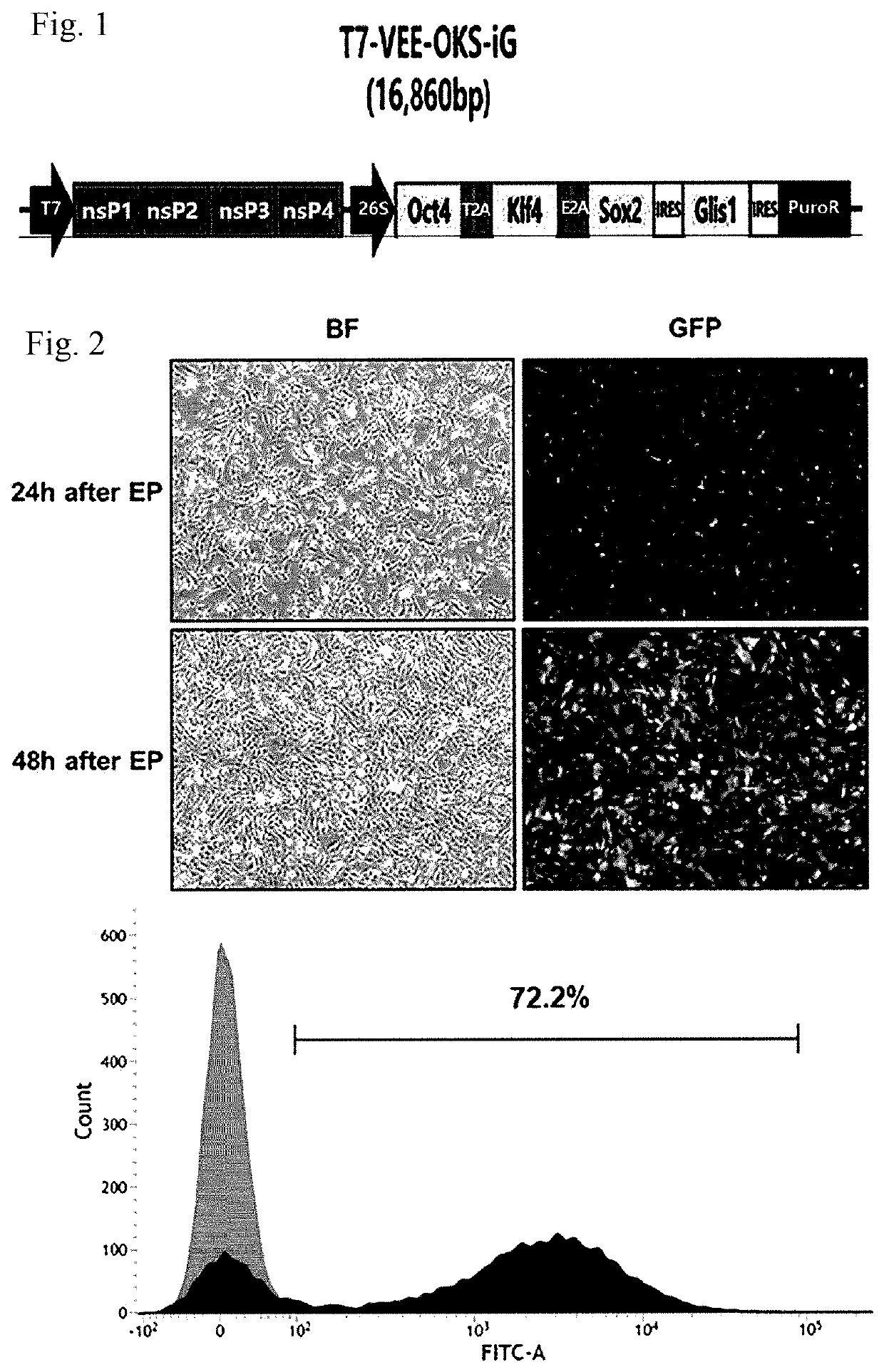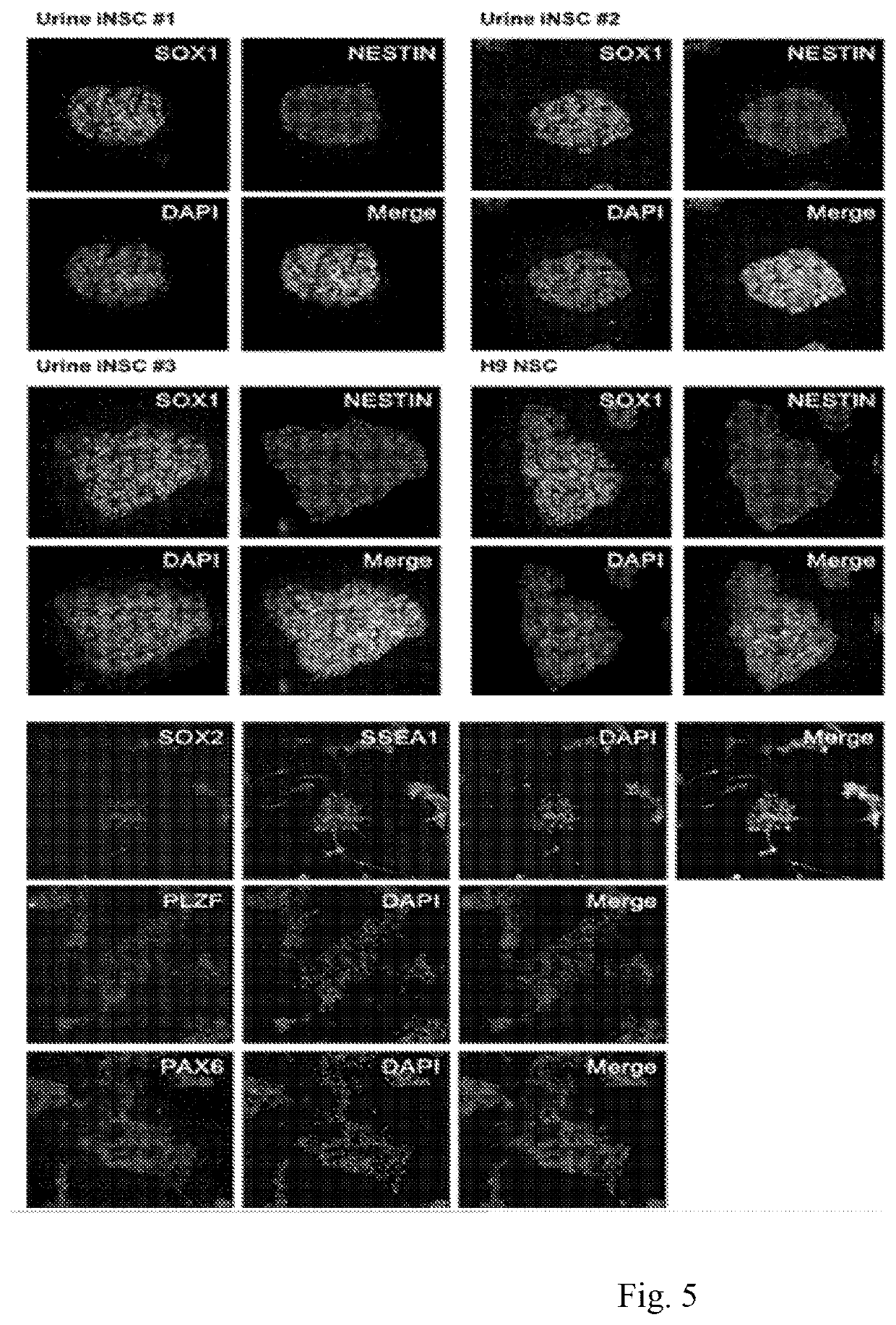A method for direct reprogramming of urine cells into neural stem cells using synthetic mRNA
- Summary
- Abstract
- Description
- Claims
- Application Information
AI Technical Summary
Benefits of technology
Problems solved by technology
Method used
Image
Examples
example 1
[0066]Based on a technique developed by Sutherland and Bain in the United Kingdom in 1972, the specifics are as follows. First, the urine donated by a donor was centrifuged at 1000 g for 10 minutes. After the supernatant was removed, the pellet remaining in the lower layer was diluted with 20 ml of a PBS solution containing 1% Penicillin / Streptomycin / Amphotericin B antibiotics. The diluted PBS+pellet solution was then centrifuged at 1000 g for 10 minutes. After the supernatant was removed again, the pellet remaining in the lower layer was diluted with 1 ml of a basal medium (a medium including 1% Penicillin / Streptomycin Amphotericin B antibiotics, 1% L-glutamine, and 10% FBS based on DMEMF12) and seeded onto a 12-well cell culture dish coated with gelatin. Then, after cells were cultured by adding 1 ml of the basal medium for 3 days, the cells were cultured by changing the medium to a growth medium (a medium including 1% Penicillin / Streptomycin antibiotics, ...
example 2
ion of Reprogramming Factor into Urine Cells Using Electroporation
[0067]A method of introducing synthetic mRNA into urine-derived cells cultured in Example 1 by electroporation is specifically as follows. Synthetic mRNA is synthesized through a typical in vitro transcription kit (RiboMAX⊚ Large Scale RNA Production Systems, Promega), and DNA, which becomes a backbone of mRNA to be synthesized, is T7-VEE-OKS-iG (Steven Dowdy, Addgene), which includes genes of OCT4, KLF4, SOX2, and GLIS1 (FIG. 1). As the sequences of the OCT4, KLF4, SOX2, and GLIS1 genes, those disclosed in Nature. 2011 Jun. 8; 474(7350): 225-9. were used, and for the corresponding gene sequence and mRNA application method, Cell Stem Cell. 2013 Aug. 1; 13 (2): 246-54 and U.S. Pat. No. 9,862,930 B2 were referenced.
[0068]The synthesized mRNA was introduced by treating 1×106 urine-derived cells pretreated with 0.2 ug / ml of B18R protein with 0.5 μg of the synthesized mRNA 3 times by electroporation at 1600 V and 10 ms for...
example 3
of Reprogrammed Neural Stem Cells Derived from Urine
[0070]After mRNA-introduced urine-derived cells were seeded in a cell culture dish coated with Matrigel™, the cells were cultured in a neural stem cell-inducing medium supplemented with 0.5 uM purmorphamine (Shh agonist), 10 uM forskolin (adenylyl cyclase activator), 100 uM sodium butyrate (histone deacetylase inhibitor), and 64 ug / ml ascorbic acid 2-phosphate based on a neural stem cell-inducing medium (a medium obtained by mixing a DMEM / F12 medium and a neurobasal (Gibco) medium at 1:1 and adding 1×N2 (Gibco), 1×B27 (Gibco), 10 ng / ml human LIF, 2 uM SB431542 (TGF-beta inhibitor), and 3 uM CHIR99021 (GSK3-beta inhibitor) to the medium mixture) for 7 to 10 days. The development of neural stem cell colonies could be confirmed when the induction was completed (FIG. 3).
[0071]Further, effects on the induction efficiency of neural stem cells were confirmed when one or more of a Shh agonist, an adenylyl cyclase activator, a histone deace...
PUM
 Login to View More
Login to View More Abstract
Description
Claims
Application Information
 Login to View More
Login to View More - R&D
- Intellectual Property
- Life Sciences
- Materials
- Tech Scout
- Unparalleled Data Quality
- Higher Quality Content
- 60% Fewer Hallucinations
Browse by: Latest US Patents, China's latest patents, Technical Efficacy Thesaurus, Application Domain, Technology Topic, Popular Technical Reports.
© 2025 PatSnap. All rights reserved.Legal|Privacy policy|Modern Slavery Act Transparency Statement|Sitemap|About US| Contact US: help@patsnap.com



